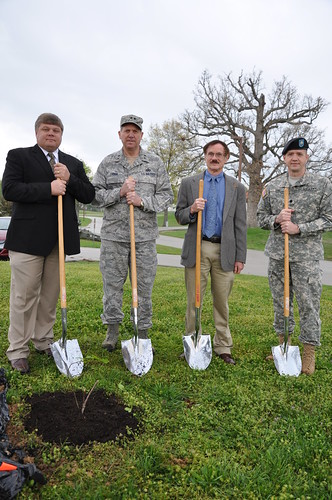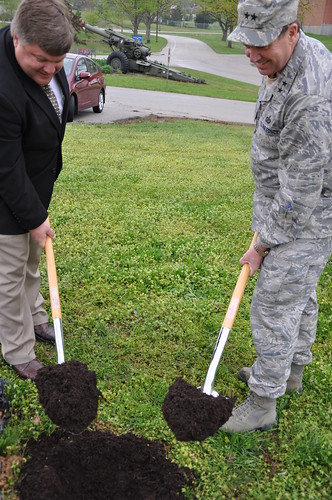keh
[caption id="" align="alignleft" width="332" caption="Bryan Burhans, American Chestnut Foundation CEO, Maj. Gen. Edward W. Tonini, state adjutant general of Kentucky, Lynn Garrison, Kentucky Chapter of the American Chestnut Foundation president and Lt. Col Steven King, Boone National Guard Center Construction and Facilities manager, break ground at BNGC chestnut tree ceremony in Frankfort, Ky., April 22."]
 Story by the Kentucky National Guard Public Affairs (pao@kentuckyguard.com)
Pictures by Staff Sgt. Michael J. Oliver, KYNG Public Affairs Office
Click here for more photos on this event
FRANKFORT, Ky. --
Story by the Kentucky National Guard Public Affairs (pao@kentuckyguard.com)
Pictures by Staff Sgt. Michael J. Oliver, KYNG Public Affairs Office
Click here for more photos on this event
FRANKFORT, Ky. -- The Kentucky National Guard honored Earth Day today during a ceremony at Boone National Guard Center where two donated American chestnuts were planted in front of the Wellman Armory. These American chestnuts were a result of the American Chestnut Foundation's breeding efforts to develop trees resistant to the chestnut blight that has destroyed nearly four billion trees.
"We are proud to be a part of this great project, " said Maj. Gen. Edward W. Tonini, adjutant general for Kentucky. "We have a proven commitment to guard the environment, especially at our training facilities for future generations."
[caption id="" align="alignright" width="332" caption="Maj. Gen. Edward W. Tonini, state adjutant general of Kentucky, and Bryan Burhans, American Chestnut Foundation CEO, dig a hole for chestnut trees at a Boone National Guard ceremony in Frankfort, Ky., April 22."]

"This Kentucky National Guard armory is a wonderful place for us to be represented, " said Lynn Garrison, president of the Kentucky Chapter of TACF. "So much of what the National Guard is doing with this area involves creating a healthier planet and this project fits right in."
"We are also planting 120 eastern white pine trees at Kentucky National Guard facilities throughout the Commonwealth, " said Tonini. "This is our commitment to Kentucky's future."
.
ABOUT THE AMERICAN CHESTNUT , ACCORDING TO THE AMERICAN CHESTNUT FOUNDATION
Wildlife and rural families alike favored the American Chestnut. Its nutritious nuts provided an important cash crop for many communities in the eastern United States. Wood from the chestnut tree was lighter than oak and virtually rot-resistant. Chestnut timber was used for everything from railroad ties to musical instruments. A foreign fungus imported to the US in 1904 devastated the tree. By 1950, the 'King of the Forest' was nearly destroyed by the chestnut blight.